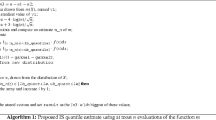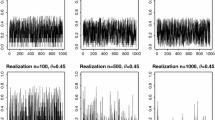Abstract
This paper deals with the estimation, under sampling in two successive occasions, of a finite population quantile. For this sampling design a class of estimators is proposed whose the ratio and difference estimators are particular cases. Asymptotic variance formulae are derived for the proposed estimators, and the optimal matching fraction is discussed. Comparisons are made with existing estimators in a simulation study using a natural population.




Similar content being viewed by others
References
Adhvaryu, D. (1978). Successive sampling using multi-auxiliary information.Sankhya 40, 167–173.
Allen, J., Singh, H. P., Singh, S. & Smarandache, F. (2002). A general class of estimatiors of population median using two auxiliary variables in double sampling. INTERSTAT.
Arnab, R. & Okafor, F. C. (1992). A note on double sampling over two occasions.Pakistan Journal of Statistics 8, 9–18.
Eckler, A. R. (1955). Rotation Sampling.The Annals of Mathematical Statistics 26, 664–685.
Efron, B. & Tibshirani, R. J. (1993).An introduction to the Bootstrap. Chapman & Hall, London.
Jessen, R. J. (1942). Statistical investigation of a sample survey for obtaining farm facts.Iowa Agricultural Experiment Statistical Research Bulletin 304.
Gordon, L. (1983). Successive sampling in finite populations.The Annals of Statistics 11, 702–706.
Hedayat, A. S. & Sinha, B. K. (1991).Design and Inference in Finite Population Sampling. John Wiley & Sons, Inc. New York.
Kuk, A. & Mak, T. K. (1989). Median estimation in the presence of auxiliary information.Journal of the Royal Statistical Society B1, 261–269.
Narain, R. D. (1953). On the recurrence formula in sampling on successive occasions.Journal of the Indian Society of Agricultural Statistics 5, 96–99.
Patterson, H. D. (1950). Sampling on successive occasions with partial replacement of units,Journal of the Royal Statistical Society B 12, 241–255.
Rueda M., Arcos, A. & Martínez-Miranda, M. D. (2003). Difference estimators of quantiles in finite populations.Test 12, 481–496.
Sen, A. Ft. (1979). Sampling theory on repeated occasions with ecological applications, in Sampling Biological Populations, 315–328.
Silverman, B. W. (1986).Density estimation for statistics and data analysis. Chapman & Hall, London.
Singh, S., Joarder, A. H. & Tracy, D. S. (2001). Median estimation using double sampling.Aust. N. Z. J. Stat. 43, 33–46.
Singh, S. (2003).Advanced sampling theory with applications: How michael “selected” Amy, pp. 1–1247, Kluwer Academic Publisher, The Netherlands.
Acknowledgements
The authors would like to thank the referees for their many helpful comments and suggestions. Research partially supported by MCYT (Spain) contract number BFM2001-3190.
Author information
Authors and Affiliations
Rights and permissions
About this article
Cite this article
Martínez-Miranda, M.D., Rueda-Garcia, M., Arcos-Cebrián, A. et al. Quantile estimation under successive sampling. Computational Statistics 20, 385–399 (2005). https://doi.org/10.1007/BF02741304
Published:
Issue Date:
DOI: https://doi.org/10.1007/BF02741304




